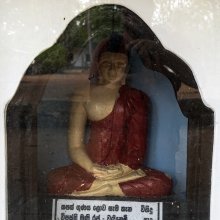Tapa, Tāpa, Tapā, Ṭāpā: 26 definitions
Introduction:
Tapa means something in Hinduism, Sanskrit, Jainism, Prakrit, Buddhism, Pali, Marathi, Hindi, Tamil. If you want to know the exact meaning, history, etymology or English translation of this term then check out the descriptions on this page. Add your comment or reference to a book if you want to contribute to this summary article.
Alternative spellings of this word include Taap.
Images (photo gallery)
(+1 more images available)
In Hinduism
Natyashastra (theatrics and dramaturgy)
Source: archive.org: The mirror of gesture (abhinaya-darpana)One of the Hands of The Seven Upper Worlds.—Tapa: the Patāka hand twisted upwards is applicable.

Natyashastra (नाट्यशास्त्र, nāṭyaśāstra) refers to both the ancient Indian tradition (shastra) of performing arts, (natya—theatrics, drama, dance, music), as well as the name of a Sanskrit work dealing with these subjects. It also teaches the rules for composing Dramatic plays (nataka), construction and performance of Theater, and Poetic works (kavya).
Purana and Itihasa (epic history)
Source: archive.org: Puranic EncyclopediaTapa (तप).—A Deva of fire-like splendour. Born of the power of penance of five sages named Kaśyapa, Vasiṣṭha, Prāṇaka, Cyavana and Trivarcas, this Deva has got a name Pāñcajanya (born of five) also. He did severe penance (tapas) and got the name Tapa. His head is like fire, his hands like Sun, his skin and eyes are of golden hue and his waist, blue. (Śloka 4, Chapter 220, Vana Parva).
Source: Cologne Digital Sanskrit Dictionaries: The Purana Index1a) Tapa (तप).—A part of Vibhu.*
- * Brahmāṇḍa-purāṇa III. 4. 24.
1b) One of the twenty Sutapa gaṇas.*
- * Brahmāṇḍa-purāṇa IV. 1. 14; Vāyu-purāṇa 100. 14.
1c) A Sukha God.*
- * Brahmāṇḍa-purāṇa IV. 1. 19.
1d) A God of Rohita gaṇa.*
- * Brahmāṇḍa-purāṇa IV. 1. 85.
1e) A son of Satarūpā.*
- * Matsya-purāṇa 4. 25.
1f) The third kalpa.*
- * Vāyu-purāṇa 21. 29.
1g) One of the Mukhya gaṇa.*
- * Vāyu-purāṇa 100. 18.
1h) A son of Raucya Manu.*
- * Vāyu-purāṇa 100. 108.
1i) (also Tapoloka) a celestial world,1 forming the forehead of Virāṭpuruṣa; the sixth loka, the residence of Ṛbhu, Sanatkumāra and others, originators of Manvantaras; each of them resides conjointly with yoga, tapa and satya; four crores of yojanas above Janaloka; the residence of the celestial Vairājas; above it, the Satyaloka or Brahmaloka.2
- 1) Bhāgavata-purāṇa II. 1. 28; VIII. 20. 34; XI. 24. 14; Matsya-purāṇa 61. 1; 184. 23.
- 2) Vāyu-purāṇa 101. 17, 37, 211; 101. 208; Viṣṇu-purāṇa II. 7. 14-15.
1j) The month of Māśi, (Feb.-Mar.) sacred to Pūṣa.*
- * Bhāgavata-purāṇa XII. 11. 39; Vāyu-purāṇa 30. 9; 50. 202.
1k) The essence milked by Bṛhaspati from cow-earth in the vessel of the Veda; practised by Yayātī; greater than sacrifices.1 Fasting and restraint lead to vairāgya; other features are celibacy, prayer and silence.2
2) Tapā (तपा).—An adopted son of Vastāvana.*
- * Vāyu-purāṇa 96. 190.

The Purana (पुराण, purāṇas) refers to Sanskrit literature preserving ancient India’s vast cultural history, including historical legends, religious ceremonies, various arts and sciences. The eighteen mahapuranas total over 400,000 shlokas (metrical couplets) and date to at least several centuries BCE.
Vaishnavism (Vaishava dharma)
Source: Pure Bhakti: Bhagavad-gita (4th edition)Tapa (तप) refers to “austerity”. (cf. Glossary page from Śrīmad-Bhagavad-Gītā).

Vaishnava (वैष्णव, vaiṣṇava) or vaishnavism (vaiṣṇavism) represents a tradition of Hinduism worshipping Vishnu as the supreme Lord. Similar to the Shaktism and Shaivism traditions, Vaishnavism also developed as an individual movement, famous for its exposition of the dashavatara (‘ten avatars of Vishnu’).
Ayurveda (science of life)
Source: gurumukhi.ru: Ayurveda glossary of termsTāpa (ताप):—Heat; Hotness; Temperature

Āyurveda (आयुर्वेद, ayurveda) is a branch of Indian science dealing with medicine, herbalism, taxology, anatomy, surgery, alchemy and related topics. Traditional practice of Āyurveda in ancient India dates back to at least the first millenium BC. Literature is commonly written in Sanskrit using various poetic metres.
Yoga (school of philosophy)
Source: ORA: Amanaska (king of all yogas): A Critical Edition and Annotated Translation by Jason BirchTāpa (ताप) refers to “heat”, according to the Amṛtasiddhi (verse 24.1-2).—Accordingly, [while describing kāyasiddhi in terms redolent of tapas (i.e., purification and bindu):] “When the accomplishment of [destroying] the [five] impurities [is achieved], as well as the union of the two Bindus, then one should know the body to be perfected and endowed with all good qualities. [Such a Siddha] is free from cold, heat (tāpa), thirst, fear, desire and greed. He has crossed over the ocean of anxiety, disease, fever, suffering and grief”.

Yoga is originally considered a branch of Hindu philosophy (astika), but both ancient and modern Yoga combine the physical, mental and spiritual. Yoga teaches various physical techniques also known as āsanas (postures), used for various purposes (eg., meditation, contemplation, relaxation).
In Jainism
General definition (in Jainism)
Source: Wisdom Library: JainismTāpa (ताप, “agony”) refers to “the feeling of distress owing to disgrace” and is one of the causes leading to the influx (āsrana) of karmas extending unpleasant feelings (asātāvedanīya).
Tāpa is a Sanskrit technical term defined in the Tattvārthasūtra (ancient authorative Jain scripture) from the 2nd century, which contains aphorisms dealing with philosophy and the nature of reality.
Source: HereNow4U: Bhagwaan Mahaveer Evam Jain DarshanTapa (तप) or Austerities are of two kinds: external and internal; external austerities are of six kinds and internal austerities are of six kinds. The body is prepared to bear suffering (parīṣaḥ) and to practice renunciation of pleasure through the external tapa. The soul starts glittering through the internal tapa. The meaning of tapa in reference to nirjarā is internal tapa. The importance of tapa is stated in all spiritual philosophies.

Jainism is an Indian religion of Dharma whose doctrine revolves around harmlessness (ahimsa) towards every living being. The two major branches (Digambara and Svetambara) of Jainism stimulate self-control (or, shramana, ‘self-reliance’) and spiritual development through a path of peace for the soul to progess to the ultimate goal.
Languages of India and abroad
Pali-English dictionary
Source: BuddhaSasana: Concise Pali-English Dictionarytapa : (m.; nt.) (mano-group) penance; religious austerity; morality. (in cpds. this changes it's last vowel a to o and stands as tapo.)
Source: Sutta: The Pali Text Society's Pali-English DictionaryTapa, & Tapo (from tapati, cp. Lat. tepor, heat) 1. torment, punishment, penance, esp. religious austerity, selfchastisement, ascetic practice. This was condemned by the Buddha: Gotamo sabbaṃ tapaṃ garahati tapassiṃ lūkhajīviṃ upavadati D. I, 161=S. IV, 330; anattha-sañhitaṃ ñatvā yaṃ kiñci aparaṃ tapaṃ S. I, 103; J. IV, 306 (tattatapa: see tatta).—2. mental devotion, self-control, abstinence, practice of morality (often= brahmacariyā & saṃvara); in this sense held up as an ideal by the Buddha. D. III, 42 sq. , 232 (attan & paran°), 239; S. I, 38, 43; IV, 118, 180; M. II, 155, 199; D. II, 49= Dh. 184 (paramaṃ tapo), 194 (tapo sukho); Sn. 77= S. I, 172 (saddhā bījaṃ tapo vuṭṭhi); Sn. 267 (t. ca brahmacariyā ca), 655 (id.), 901; Pv. I, 32 (Instr. tapasā= brahmacariyena PvA. 15); J. I, 293; Nett 121 (+indriyasaṃvara); KhA 151 (pāpake dhamme tapatī ti tapo): VvA. 114 (Instr. tapasā); PvA. 98.

Pali is the language of the Tipiṭaka, which is the sacred canon of Theravāda Buddhism and contains much of the Buddha’s speech. Closeley related to Sanskrit, both languages are used interchangeably between religions.
Marathi-English dictionary
Source: DDSA: The Molesworth Marathi and English Dictionaryṭapa (टप).—m A large marble, a taw. 2 Either half of a tent. khālalēṃ ṭapa or āntalēṃ ṭapa The shell. varalēṃ ṭapa The fly.
--- OR ---
ṭāpa (टाप) [or टांप, ṭāmpa].—f A stroke from the fore foot of a horse: also a kick from a hind foot. v māra. 2 Knocking on one's head with the knuckles. v māra. 3 Angry or reproving reflection upon; a taunt or twit. v māra. 4 A brisk chop or cut. v māra. 5 The longing and fretting (esp. of a child after its absent mother). v kara, ghē. 6 n A small plant (esp. of an esculent vegetable): also the head or tender sproutings. ṭāpēkhālīṃ asaṇēṃ-cālaṇēṃ-rāhaṇēṃ-vāgaṇēṃ To live and move under the paw of.
--- OR ---
tapa (तप).—n (S) Religious austerity; pious mortification of the body. 2 Virtue or moral merit. 3 A term of twelve years. 4 Duty, special duty, peculiar or prescribed duty (as of the Brahman, Kshatriya &c.) 5 In ornate composition. Heater or heating; as nētrantapa, bhālantapa śirastapa, aṅgantapa, manastapa, cittantapa, antastapa, bahistapa, pādāntapa, indriyantapa Heating to the eyes, forehead, head &c. tapīṃ basaṇēṃ To be undergoing some austere infliction or exercise (for the acquisition of puṇya or merit with God). Hence fig. To sit at home out of employ. karūna karūna tapīṃ basaṇēṃ To perpetrate wicked deeds ever and anon, assuming after each great devoutness and sanctity. tapēṃ tapaṇēṃ To be engaged in religious austerities. Ex. jē tīrtha karitāṃ bhāgalē || ananta janmīṃ tapēṃ tapalē ||.
--- OR ---
tāpa (ताप).—m (tapa S) Fever. 2 Heat (of the sun or of fire: also heatedness (as of bodies by the sun or fire). 3 fig. Heat of rage or lust; turmoil of worldly business; tumultuous agitation; anxious inquietude &c. 4 Oppression or harassing (as of creditors, robbers, rats, vermin &c.) 5 Hot sunshine in the rainy season or just after.
--- OR ---
tāpā (तापा).—m A float, a raft &c. Better tāphā q. v. Sig. II.
Source: DDSA: The Aryabhusan school dictionary, Marathi-Englishṭāpa (टाप) [or ṭāmpa, or टांप].—f A stroke from the fore root of a horse: also a kick from a hind foot. A brisk chop or cut. v māra. The longing and fretting (esp. of a child after its absent mother). v kara, ghē. ṭāpēkhālīṃ asaṇēṃ-cālaṇēṃ-rāhaṇēṃ-vāgaṇēṃ To live and move under the paw of.
--- OR ---
tapa (तप).—n Religious austerity. Virtue. A term of 12 years. Duty.
--- OR ---
tāpa (ताप).—m Fever. Heat. Heat of rage. Trou- ble, bother. Oppression.
Marathi is an Indo-European language having over 70 million native speakers people in (predominantly) Maharashtra India. Marathi, like many other Indo-Aryan languages, evolved from early forms of Prakrit, which itself is a subset of Sanskrit, one of the most ancient languages of the world.
Sanskrit dictionary
Source: DDSA: The practical Sanskrit-English dictionaryTapa (तप).—a. [tap-ac]
1) Burning, warming, consuming by heat.
2) Causing pain or trouble, distressing.
-paḥ 1 Heat, fire, warmth.
2) The sun; तपतपनसहस्रद्योतवद्- दुर्निरीक्ष्यम् (tapatapanasahasradyotavad- durnirīkṣyam) (tejaḥ) Rām. Ch.2.85.
3) The hot season; Śiśupālavadha 1.66.
4) Penance, religious austerities.
--- OR ---
Tāpa (ताप).—[tap-ghañ]
1) Heat, glow; अर्कमयूखतापः (arkamayūkhatāpaḥ) Ś.4.11; M.2.13; Manusmṛti 12.76; Kumārasambhava 7.84.
2) Torment, pain, affliction, misery, agony; इतरतापशतानि तवेच्छया वितर तानि सहे चतुरानन (itaratāpaśatāni tavecchayā vitara tāni sahe caturānana) Udb.; समस्तापः कामं मनसिजनिदाघप्रसरयोः (samastāpaḥ kāmaṃ manasijanidāghaprasarayoḥ) Ś3.8; Bhartṛhari 1.16.
3) Sorrow, distress.
4) A circle or heap of rays; प्रतिरूपं यथैवाप्सु तापः सूर्यस्य लक्ष्यते (pratirūpaṃ yathaivāpsu tāpaḥ sūryasya lakṣyate) Mahābhārata (Bombay) 12.253.3.
-pī The Tāptī river (also Yamunā); Bhāgavata 5.19.18; 1.79.2.
Derivable forms: tāpaḥ (तापः).
--- OR ---
Tāpa (ताप).—&c. See under तप् (tap).
See also (synonyms): tāpana.
Source: Cologne Digital Sanskrit Dictionaries: Edgerton Buddhist Hybrid Sanskrit DictionaryTapā (तपा).—name of one of the 8 deities of the Bodhi-tree: Lalitavistara 331.21.
--- OR ---
Tāpa (ताप).—(°-) = tapas, ascetic practice (a meaning unrecorded for tāpa or its MIndic equivalents); in Mahāvyutpatti 1608, chapter- title, tāpa-saṃvāra-paryāyāḥ, words for ascetic practices and restraints; saṃvāra is also unparallelled in the sense of saṃvara; Tibetan dkaḥ thub, which regularly = tapas, and sdom pa, which regularly = saṃvara. Perhaps read tapaḥ-saṃvara-; but Mironov (p. vi) cites both words as in Kyoto ed.
Source: Cologne Digital Sanskrit Dictionaries: Shabda-Sagara Sanskrit-English DictionaryTapa (तप).—m.
(-paḥ) 1. The hot season, summer. 2. Heat, warmth. 3. The sun. E. tap to heat, affix ac.
--- OR ---
Tāpa (ताप).—m.
(-paḥ) 1. Heat, burning, (moral or physical.) 2. Pain, sorrow, distress. E. tap to burn or inflame, affix ghañ. f. (-pī) A name of the Tapti or Surat river. 2. A name of the Yamuna or Jamna river. E. tapa the sun, affix of descent ac, ṅīṣ .
Source: Cologne Digital Sanskrit Dictionaries: Benfey Sanskrit-English DictionaryTapa (तप).—[tap + a], I. adj. 1. Illuminating. 2. Tormenting, e. g. paraṃtapa. Ii. m. 1. Heat, [Pañcatantra] 121, 13. 2. The hot season, [Śiśupālavadha] 1, 66. 3. Penance, [Harivaṃśa, (ed. Calc.)] 15434.
--- OR ---
Tāpa (ताप).—i. e. tap + a, m. 1. Heat, [Mānavadharmaśāstra] 12, 76. 2. Pain, Mahābhārata 1, 4405. 3. Sorrow, [Rāmāyaṇa] 2, 22, 10.
Source: Cologne Digital Sanskrit Dictionaries: Cappeller Sanskrit-English DictionaryTapa (तप).—[adjective] heating, burning, tormenting (—°); [masculine] heat, fire, penance, religious austerity.
--- OR ---
Tāpa (ताप).—[masculine] heat, ardour, pain, affiction.
Source: Cologne Digital Sanskrit Dictionaries: Monier-Williams Sanskrit-English Dictionary1) Tapa (तप):—[from tap] mfn. ifc. ‘consuming by heat’ See lalāṭam-
2) [v.s. ...] ‘causing pain or trouble, distressing’ See janaṃand paraṃ-
3) [v.s. ...] tormented by, [Harivaṃśa i, 45, 37]
4) [v.s. ...] m. heat, warmth (cf. ā-), [Pañcatantra ii, 3, 5/6]
5) [v.s. ...] the hot season, [Śiśupāla-vadha i, 66]
6) [v.s. ...] the sun, [Horace H. Wilson]
7) [v.s. ...] = pas, religious austerity, [Caraka; Cāṇakya] (cf. mahāand su-)
8) [v.s. ...] a peculiar form of fire (which generated the seven mothers of Skanda), [Mahābhārata iii, 14392]
9) [v.s. ...] Indra, [Demetrius Galanos’s Lexiko: sanskritikes, anglikes, hellenikes]
10) [v.s. ...] Name of an attendant of Śiva, [cf. Lexicographers, esp. such as amarasiṃha, halāyudha, hemacandra, etc. [Scholiast or Commentator]]
11) Tapā (तपा):—[from tapa > tap] f. Name of one of the 8 deities of the Bodhi-vṛkṣa, [Lalita-vistara xxi, 404]
12) Tapa (तप):—[from tap] cf. a-.
13) Tāpa (ताप):—m. (√2. tap; [gana] uñchādi) heat, glow, [Manu-smṛti xii, 76; Śakuntalā] etc. (ifc. f(ā). , [Kumāra-sambhava vii, 84])
14) heating, [Nyāyamālā-vistara x, 1, 22]
15) testing (gold) by heat, [Mahābhārata xii, 12357; Subhāṣitāvali] (pana, GarP.)
16) pain (mental or physical), sorrow, affliction, [Mahābhārata] etc.
17) fever, [Horace H. Wilson]
18) cf. paścāt-.
Source: Cologne Digital Sanskrit Dictionaries: Yates Sanskrit-English Dictionary1) Tapa (तप):—(paḥ) 1. m. The hot season; heat.
2) Tāpa (ताप):—(paḥ) 1. m. Heat; pain. f. (pī) The river Yamunā, or Tapti.
Source: DDSA: Paia-sadda-mahannavo; a comprehensive Prakrit Hindi dictionary (S)Tāpa (ताप) in the Sanskrit language is related to the Prakrit words: Tava, Tāva, Payava.
[Sanskrit to German]
Sanskrit, also spelled संस्कृतम् (saṃskṛtam), is an ancient language of India commonly seen as the grandmother of the Indo-European language family (even English!). Closely allied with Prakrit and Pali, Sanskrit is more exhaustive in both grammar and terms and has the most extensive collection of literature in the world, greatly surpassing its sister-languages Greek and Latin.
Hindi dictionary
Source: DDSA: A practical Hindi-English dictionary1) Ṭapa (टप):—(nf) the sound made by dripping liquid or falling fruits, etc.; the hood of a tonga, etc.; ~[ṭapa] patter, pattering sound; —[se] instantly; with a patter.
2) Ṭāpa (टाप) [Also spelled taap]:—(nf) tramp (of a horse); hoof; (nm) hood (of a tonga, etc.).
3) Tapa (तप) [Also spelled tap]:—(nm) devout austerity, asceticism, self-mortification, penance.
4) Tāpa (ताप) [Also spelled taap]:—(nm) heat; temperature; pyrexia, fever; affliction, mental agony; (a) thermal; ~[krama] temperature scale; ~[grāhī] thermoreceptor; -[taraṃga] heat-wave; ~[traya] the triple affliction i.e. physical ([daihika]), divine ([daivika]) and mundane ([bhautika]); ~[māna] temperature; •[citra] temperature map; ~[māpī] a thermometer; ~[miti] thermometry; ~[lekhī] thermometrograph, thermograph; ~[saha] thermostabile; ~[hara/~hārī] causing to counter an affliction; causing temperature to go down.
...
Kannada-English dictionary
Source: Alar: Kannada-English corpusTapa (ತಪ):—[noun] the eleventh month in Hindu calendar.
--- OR ---
Tapa (ತಪ):—
1) [noun] the quality of being hot; hotness; heat.
2) [noun] brightness; radiance; brilliance.
3) [noun] the warmest season of the year; summer.
4) [noun] a restraining of one’s biological needs, controlling of passions as a penance and living a moral and austere life, to achieve spiritual height.
5) [noun] an afflicted condition; pain; suffering; affliction.
--- OR ---
Tapa (ತಪ):—[noun] a term of twelve years.
--- OR ---
Tāpa (ತಾಪ):—
1) [noun] the quality of being hot; hotness; heat.
2) [noun] the condition of having physical or mental distress; a distressing or difficult situation.
Kannada is a Dravidian language (as opposed to the Indo-European language family) mainly spoken in the southwestern region of India.
Tamil dictionary
Source: DDSA: University of Madras: Tamil LexiconṬāpā (டாபா) noun < Telugu ḍābā. Open terrace; மேல்மெத்தையின் வெளியிடம். [melmethaiyin veliyidam.] Madras usage
--- OR ---
Tapā (தபா) noun < Arabic dafa. Time, occasion, turn; தடவை. இரண்டு தபா வந்துபோனான். [thadavai. irandu thapa vanthuponan.]
Tamil is an ancient language of India from the Dravidian family spoken by roughly 250 million people mainly in southern India and Sri Lanka.
Nepali dictionary
Source: unoes: Nepali-English Dictionary1) Ṭapa (टप):—n. 1. hood; roof; roof-top; 2. top;
2) Ṭāpā (टापा):—n. pl. of टापो [ṭāpo]
3) Tāpa (ताप):—n. 1, heat; 2. fever; 3. regret; grief; affliction; misery;
Nepali is the primary language of the Nepalese people counting almost 20 million native speakers. The country of Nepal is situated in the Himalaya mountain range to the north of India.
See also (Relevant definitions)
Starts with (+386): Taapadharan-kshamta, Tapa-cloth-tree, Tapa-Kana-Kara-Dishim-Dini, Tapa-parimapaka, Tapa-rasayanika-samikarana, Tapa-sancalana, Tapaalwyn, Tapaatanka, Tapabhrit, Tapacan, Tapacappiriyai, Tapaci, Tapacil, Tapacile, Tapaciyam, Tapacu, Tapacu-nal-cuttapocanam, Tapaculo, Tapacunal, Tapacunal-orucanti.
Ends with (+245): Abhisamtapa, Abhisantapa, Abhitapa, Abhitripishtapa, Abhyamtaramamtapa, Abhyantaratapas, Acamlavardhanatapa, Adhyatmatapas, Agnitapas, Amritapa, Amsabhitapa, Amtastapa, Anabhitapa, Anashanatapa, Anatapa, Angasamtapa, Animishavishtapa, Antahsantapa, Antartapa, Antastapa.
Full-text (+914): Tapas, Tava, Abhitapa, Atapa, Tapasya, Tapahara, Anutapa, Tapasa, Tapatyaya, Pancatapa, Atapaska, Tapastaksha, Atapas, Tapoloka, Pashcattapa, Antastapa, Taporashi, Tapahsthali, Tapati, Urutapa.
Relevant text
Search found 179 books and stories containing Tapa, Daapaa, Dapa, Dhapa, Tāpa, Tapā, Ṭapa, Ṭāpa, Tāpā, Ṭāpā, Thapa, Thapaa; (plurals include: Tapas, Daapaas, Dapas, Dhapas, Tāpas, Tapās, Ṭapas, Ṭāpas, Tāpās, Ṭāpās, Thapas, Thapaas). You can also click to the full overview containing English textual excerpts. Below are direct links for the most relevant articles:
Tattvartha Sutra (with commentary) (by Vijay K. Jain)
Verse 9.19 - The six kinds of external austerities (bāhya-tapas) < [Chapter 9 - Stoppage and Shedding of Karmas]
Verse 9.20 - The six kinds of internal austerities (ābhyantara-tapa) < [Chapter 9 - Stoppage and Shedding of Karmas]
Verse 6.11 - The nature of Unpleasant-feeling Karmas < [Chapter 6 - Influx of Karmas]
Jainism and Patanjali Yoga (Comparative Study) (by Deepak bagadia)
External Austerities (Tapas) < [Chapter 3 - Jain Philosophy and Practice]
Internal Austerities (Tapas) < [Chapter 3 - Jain Philosophy and Practice]
Part 9 - Supernatural powers: Siddhis < [Chapter 4 - A Comparative Study]
Garga Samhita (English) (by Danavir Goswami)
Verses 2.24.29-31 < [Chapter 24 - The Story of Asuri Muni in the Rāsa-dance Pastime]
Verse 2.1.34 < [Chapter 1 - Description of the Entrance in Vṛndāvana]
Verse 6.2.33 < [Chapter 2 - Residence in Śrī Dvārakā]
Rig Veda (translation and commentary) (by H. H. Wilson)
Mundaka Upanishad with Shankara’s Commentary (by S. Sitarama Sastri)
Verse 1.1.9 < [Mundaka I, Khanda I]
Verse 3.1.5 < [Mundaka III, Khanda I]
Verse 3.2.4 < [Mundaka III, Khanda II]
Prasthanatrayi Swaminarayan Bhashyam (Study) (by Sadhu Gyanananddas)
8.3. Significance of Tapa (austerities) < [Chapter 4 - Analysis on the Basis of Spiritual Endeavour]
12.2. Virtues Helpful in Spiritual Progress < [Chapter 4 - Analysis on the Basis of Spiritual Endeavour]
10.4. Pativratā-bhakti < [Chapter 4 - Analysis on the Basis of Spiritual Endeavour]
Related products
(+2 more products available)











